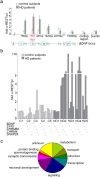Widespread disruption of repressor element-1 silencing transcription factor/neuron-restrictive silencer factor occupancy at its target genes in Huntington's disease
- PMID: 17596446
- PMCID: PMC6672230
- DOI: 10.1523/JNEUROSCI.4278-06.2007
Widespread disruption of repressor element-1 silencing transcription factor/neuron-restrictive silencer factor occupancy at its target genes in Huntington's disease
Abstract
Huntingtin is a protein that is mutated in Huntington's disease (HD), a dominant inherited neurodegenerative disorder. We previously proposed that, in addition to the gained toxic activity of the mutant protein, selective molecular dysfunctions in HD may represent the consequences of the loss of wild-type protein activity. We first reported that wild-type huntingtin positively affects the transcription of the brain-derived neurotrophic factor (BDNF) gene, a cortically derived survival factor for the striatal neurons that are mainly affected in the disease. Mutation in huntingtin decreases BDNF gene transcription. One mechanism involves the activation of repressor element 1/neuron-restrictive silencer element (RE1/NRSE) located within the BDNF promoter. We now show that increased binding of the RE1 silencing transcription factor/neuron-restrictive silencer factor (REST/NRSF) repressor occurs at multiple genomic RE1/NRSE loci in HD cells, in animal models, and in postmortem brains, resulting in a decrease of RE1/NRSE-mediated gene transcription. The same molecular phenotype is produced in cells and brain tissue depleted of endogenous huntingtin, thereby directly validating the loss-of-function hypothesis of HD. Through a ChIP (chromatin immunoprecipitation)-on-chip approach, we examined occupancy of multiple REST/NRSF target genes in the postmortem HD brain, providing the first example of the application of this technology to neurodegenerative diseases. Finally, we show that attenuation of REST/NRSF binding restores BDNF levels, suggesting that relief of REST/NRSF mediated repression can restore aberrant neuronal gene transcription in HD.
Figures




Similar articles
-
Analysis of the repressor element-1 silencing transcription factor/neuron-restrictive silencer factor occupancy of non-neuronal genes in peripheral lymphocytes from patients with Huntington's disease.Brain Pathol. 2010 Jan;20(1):96-105. doi: 10.1111/j.1750-3639.2008.00249.x. Epub 2008 Dec 23. Brain Pathol. 2010. PMID: 19134002 Free PMC article.
-
Huntingtin interacts with REST/NRSF to modulate the transcription of NRSE-controlled neuronal genes.Nat Genet. 2003 Sep;35(1):76-83. doi: 10.1038/ng1219. Epub 2003 Jul 27. Nat Genet. 2003. PMID: 12881722
-
Binding of the repressor complex REST-mSIN3b by small molecules restores neuronal gene transcription in Huntington's disease models.J Neurochem. 2013 Oct;127(1):22-35. doi: 10.1111/jnc.12348. Epub 2013 Jul 19. J Neurochem. 2013. PMID: 23800350
-
Transcriptional dysregulation of coding and non-coding genes in cellular models of Huntington's disease.Biochem Soc Trans. 2009 Dec;37(Pt 6):1270-5. doi: 10.1042/BST0371270. Biochem Soc Trans. 2009. PMID: 19909260 Review.
-
Turning REST/NRSF dysfunction in Huntington's disease into a pharmaceutical target.Curr Pharm Des. 2009;15(34):3958-67. doi: 10.2174/138161209789649303. Curr Pharm Des. 2009. PMID: 19751206 Review.
Cited by
-
Analysis of the repressor element-1 silencing transcription factor/neuron-restrictive silencer factor occupancy of non-neuronal genes in peripheral lymphocytes from patients with Huntington's disease.Brain Pathol. 2010 Jan;20(1):96-105. doi: 10.1111/j.1750-3639.2008.00249.x. Epub 2008 Dec 23. Brain Pathol. 2010. PMID: 19134002 Free PMC article.
-
REST, a master transcriptional regulator in neurodegenerative disease.Curr Opin Neurobiol. 2018 Feb;48:193-200. doi: 10.1016/j.conb.2017.12.008. Epub 2018 Jan 30. Curr Opin Neurobiol. 2018. PMID: 29351877 Free PMC article. Review.
-
Mild Inactivation of RE-1 Silencing Transcription Factor (REST) Reduces Susceptibility to Kainic Acid-Induced Seizures.Front Cell Neurosci. 2020 Jan 10;13:580. doi: 10.3389/fncel.2019.00580. eCollection 2019. Front Cell Neurosci. 2020. PMID: 31998079 Free PMC article.
-
More than a Corepressor: The Role of CoREST Proteins in Neurodevelopment.eNeuro. 2020 Mar 10;7(2):ENEURO.0337-19.2020. doi: 10.1523/ENEURO.0337-19.2020. Print 2020 Mar/Apr. eNeuro. 2020. PMID: 32075869 Free PMC article. Review.
-
NRSF: an angel or a devil in neurogenesis and neurological diseases.J Mol Neurosci. 2015 May;56(1):131-44. doi: 10.1007/s12031-014-0474-5. Epub 2014 Dec 6. J Mol Neurosci. 2015. PMID: 25479824 Review.
References
-
- Belyaev ND, Wood IC, Bruce AW, Street M, Trinh JB, Buckley NJ. Distinct RE-1 silencing transcription factor-containing complexes interact with different target genes. J Biol Chem. 2004;279:556–561. - PubMed
-
- Busch A, Engemann S, Lurz R, Okazawa H, Lehrach H, Wanker EE. Mutant huntingtin promotes the fibrillogenesis of wild-type huntingtin: a potential mechanism for loss of huntingtin function in Huntington's disease. J Biol Chem. 2003;278:41452–41461. - PubMed
-
- Cattaneo E, Rigamonti D, Goffredo D, Zuccato C, Squitieri F, Sipione S. Loss of normal huntingtin function: new developments in Huntington's disease research. Trends Neurosci. 2001;24:182–188. - PubMed
Publication types
MeSH terms
Substances
Grants and funding
LinkOut - more resources
Full Text Sources
Other Literature Sources
Medical
